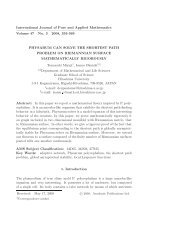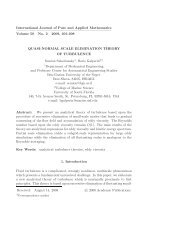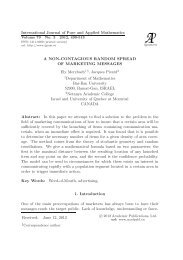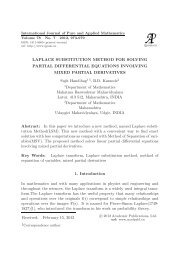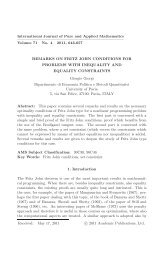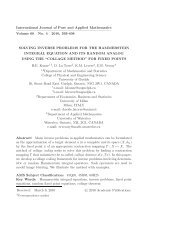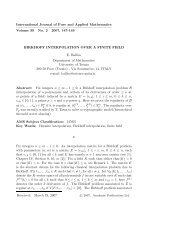WHY DO BOOMERANGS COME BACK? Yutaka Nishiyama ...
WHY DO BOOMERANGS COME BACK? Yutaka Nishiyama ...
WHY DO BOOMERANGS COME BACK? Yutaka Nishiyama ...
You also want an ePaper? Increase the reach of your titles
YUMPU automatically turns print PDFs into web optimized ePapers that Google loves.
International Journal of Pure and Applied Mathematics<br />
Volume 78 No. 3 2012, 335-347<br />
ISSN: 1311-8080 (printed version)<br />
url: http://www.ijpam.eu<br />
<strong>WHY</strong> <strong>DO</strong> <strong>BOOMERANGS</strong> <strong>COME</strong> <strong>BACK</strong>?<br />
<strong>Yutaka</strong> <strong>Nishiyama</strong><br />
Department of Business Information<br />
Faculty of Information Management<br />
Osaka University of Economics<br />
2, Osumi Higashiyodogawa Osaka, 533-8533, JAPAN<br />
PA<br />
ijpam.eu<br />
Abstract: After touching on the three most common misconceptions regarding<br />
boomerangs, the author goes on to explain why boomerangs are crescent<br />
shaped. The author explains, using the principle of precessional motion, why<br />
boomerangs turn leftwards and why they fall sideways. He performs a comprehensive<br />
analysis through the “right-hand rule,” using the example of a gyro<br />
top. The author also explains how to make and fly the boomerang he invented<br />
— one that can be flown inside a room and returns correctly.<br />
AMS Subject Classification: 00A79, 70E05, 97A20<br />
Key Words: moment of inertia, lift force, left turn and sideways fall, torque,<br />
couple, precessional motion, gyroscopic effect, right-hand rule<br />
1. Certain Misconceptions<br />
The space available here is far too limited for one to discuss the subject of<br />
boomerangsat length. I would like to offer adetailed explanation on such issues<br />
as the ways to make boomerangs and their throwing techniques, methods for<br />
control and coordination, and boomeranging as a competitive sport; however,<br />
I have no other option but to omit all such practical aspects here.<br />
My initial research (<strong>Nishiyama</strong>, 1978, [4]) was by no means exhaustive;<br />
however, by referring to the research conduced by Felix Hess (1968, [2]) and<br />
Received: December 14, 2011<br />
c○ 2012 Academic Publications, Ltd.<br />
url: www.acadpubl.eu
336 Y. <strong>Nishiyama</strong><br />
Jearl Walker (1979, [3]), both the theory and technique have progressed to a<br />
large extent, and it can now be said to be very near completion (<strong>Nishiyama</strong>,<br />
2002, [5]). In this article, I put forward explanations focusing on reasons why<br />
boomerangs fly back.<br />
There are three commonly perceived causes as to why a boomerang comes<br />
back:<br />
1. Because it is crescent shaped<br />
2. Wind power forces it back<br />
3. Follows the same principle as the curving of a spinning baseball<br />
First and foremost, it is a misconception to believe that a boomerang flies<br />
back because it is shaped in a crescent form. A look at the boomerang models<br />
that are presently popular should explain why. There are boomerangs in the<br />
market that have three or four wings. There are even some that are shaped<br />
like a kangaroo or seagull. There are all constructed to allow them to come<br />
back to the thrower. The issue of whether all these can be called boomerangs<br />
often comes under debate. For a cultural anthropologist, a crescent-shaped<br />
object would constitute a boomerang regardless of whether it comes back to<br />
the thrower; a natural scientist, on the other hand, would call any object that<br />
come back to the location of the thrower a boomerang regardless of the shape<br />
or number of wings.<br />
Second, that a boomerang comes back due to the presence of wind is also a<br />
misconception. For this, it is enough for one to understand that a boomerang<br />
will come back even inside a room where there is no wind. Wind is not a direct<br />
cause for its coming back. It is the presence of air and not wind that causes a<br />
boomerang to come back. It will return as long as there is air present.<br />
The third and final supposed cause, namely that the curve principle causes<br />
the return, is also a misconception. When a baseball is made to spin with<br />
force at the time it is thrown, it either curves or shoots, causing a horizontal<br />
change in the path. This is called the Magnus Effect after the name of its<br />
discoverer. According to the work of Shinji Sakurai [1], a curveball thrown at<br />
the initial velocity of 30 m/second will reach the home base 18 m away with<br />
a horizontal shift of 40 cm. This change in direction by the Magnus Effect is<br />
extremely small. The protagonist in the comic book Kyojin no Hoshi (The Star<br />
of Giants) is shown throwing a baseball from inside a room and catching it on<br />
its way back, but this is pure imagination.
<strong>WHY</strong> <strong>DO</strong> <strong>BOOMERANGS</strong> <strong>COME</strong> <strong>BACK</strong>? 337<br />
2. Why Is a Boomerang Crescent Shaped?<br />
The first weapons of early hunting tribes were stones and sticks. What happens<br />
when these are thrown into the air? A stone will fly in a parabolic movement,<br />
but that would not happen with a stick. Even if thrown with great force, a<br />
stick will only twirl in the air to fall down on the ground and not go far. That<br />
is because a stick rotates. A stone can work as a material particle, but a stick<br />
has to be considered a rigid body.<br />
Rotary motion is governed by the property that an object at rest remains at<br />
rest and an object in rotation always remains in rotation. This is a well-known<br />
law of Newton. Moment of inertia, which is calculated by multiplying mass by<br />
distance squared, is a physical quantity that signifies the ease or difficulty of<br />
rotation.<br />
There are three coordinates that form the basis for the centre of gravity of<br />
a board. The direction of the width forms the x-axis, the length the y-axis, and<br />
the thickness the z-axis. Each of the three axes has its own moment of inertia<br />
surrounding it; in terms of comparative size, the moment of inertia around the<br />
z-axis is the greatest, followed by the x-axis and finally the y-axis.<br />
Figure 1: Three moments of inertia<br />
The significance of this is that rotation around the z-axis is difficult to bring<br />
to rest if in motion and difficult to set into motion if at rest; the y-axis rotation<br />
is the easiest to bring to rest or to set into motion.<br />
If the z-axis around which the moment of inertia is largest is made to rotate,<br />
with any disturbance in the air disenabling the rotating motion to be
338 Y. <strong>Nishiyama</strong><br />
maintained, it will immediately shift to rotation around the y-axis where the<br />
moment of inertia is the least. Thus, the board has to be curved to overcome<br />
this drawback. By curving the board, its apparent length is reduced and the<br />
width increases. Also, width-wise, air resistance increases, making it difficult<br />
for the y-axis to rotate (Figure 1).<br />
Another interesting point concerns shifting the centre of gravity of the<br />
board. If a board that has been shaped in a crescent form is thrown into<br />
the air, a cavity forms in the centre, making it much like a doughnut. This<br />
cavity balances the air pressure on the top and bottom surfaces of the board,<br />
thus increasing the stability of flight (Figure 2). It is for those reasons that<br />
boomerangs are curved in a crescent shape.<br />
Figure 2: A cavity is formed<br />
3. Lift Force Alone Will Not Make a Boomerang Fly Back<br />
A boomerang comes flying back. In other words, flying and coming back are<br />
the key parameters. First and foremost, lifting power or lift force is necessary<br />
to make a boomerang fly.<br />
Lift force is created by the flow of air; this occurs in two ways. The first<br />
depends on the shape in cross-section of the wing. This is called the aerofoil<br />
cross-section. The shape of the cross-section of an airplane wing shows that<br />
whereas the upper surface is convex, the lower surface is flat. When a wing<br />
of such a shape moves in the air at a certain speed, the airflow over the top<br />
surface is slightly distorted, whereas it passes straight and undisturbed under<br />
the lower surface. Because the distance crossed on the distorted upper surface<br />
is longer, the speed increases as compared to the air flowing under the lower<br />
surface. The surface where air speed is faster experiences lower air pressure as
<strong>WHY</strong> <strong>DO</strong> <strong>BOOMERANGS</strong> <strong>COME</strong> <strong>BACK</strong>? 339<br />
compared to the slower side; that difference in pressure creates a push from the<br />
lower surface toward the upper surface. This push is the lift force and is known<br />
as Bernoulli’s Principle.<br />
In that case, would it be correct to say that there is no lift force generated<br />
if the cross-section of the wing did not show the upper surface as having a<br />
convexity? This is not so. As is seen when throwing a celluloid sheet into<br />
the air, lift force is generated even in a flat plastic sheet. Second, lift force<br />
is generated here by a certain degree of angle of attack against the wind that<br />
is present. Angle of attack is the angle formed between the base line of the<br />
cross-section of the wing and the direction of flight, that is, the direction of<br />
flow. It is necessary that this angle be between 5 ◦ and 10 ◦ .<br />
Figure 3: Vertical throwing<br />
Figure 4: Horizontal throwing
340 Y. <strong>Nishiyama</strong><br />
Figure5: Leftturnandfallinginahorizontal position(seenfromabove)<br />
4. Boomerangs Make a Left Turn<br />
What is important when throwing a boomerang is to “throw vertically” and<br />
to give a “spin.” Ninety-nine percent of failures in boomerang throwing result<br />
from “horizontal throwing.” If the relation between the way of throwing and the<br />
trajectory of the boomerang when a right-handed person throws a boomerang<br />
is observed, it is understood that the following three phenomena occur (Figures<br />
3, 4, and 5).<br />
1. A vertical throw results in the boomerang turning left and coming back.<br />
2. A horizontal throw results in the boomerang rising steeply and falling<br />
straight down.<br />
3. A vertical throw results in the boomerang making a sideways fall and<br />
returning in the end in a horizontal position.<br />
Here, I shall begin by explaining the reasons for the above. Let us first a<br />
look at the relation between a boomerang’s forward motion and spin. Let us<br />
suppose that the boomerang shown in Figure 6 is proceeding away from the<br />
thrower at a forward velocity of 100 km/hr. and a rotational velocity of 20<br />
km/hr. If the two wings are compared, the wing on top experiences forward
<strong>WHY</strong> <strong>DO</strong> <strong>BOOMERANGS</strong> <strong>COME</strong> <strong>BACK</strong>? 341<br />
velocity of 100 km/hr. and additional rotational velocity of 20 km/hr., making<br />
the total speed 120 km/hr. The bottom wing, on the other hand, faces the<br />
direction directly opposite from that of the spin, and thus the speed is the<br />
forward velocity of 100 km/hr. minus the rotational velocity of 20 km/hr.,<br />
making it 80 km/hr. The respective air speeds now are 120 km/hr. and 80<br />
km/hr., accounting for a difference of 40 km/hr.<br />
What does the difference in speed affect? It affects the extent of lift force.<br />
The lift force is increased in high speed and consequently falls when the speed<br />
drops. Due to this difference in lift force, the force to turn the top edge toward<br />
the leftward direction, in other words in a counter clockwise direction, comes<br />
into play. This rotational force is known as torque.<br />
Because torque works in a counter clockwise direction, one would assume<br />
that the top edge should land up, being turned leftwards when seen from the<br />
thrower of the boomerang. At first, I too thought so. But this is not the case.<br />
The truth is that a completely unlooked-for phenomenon occurs.<br />
When torque comes into play to make the rotating surface rotate in a<br />
counterclockwise directionfortherotation axisoftheboomerang, anadditional<br />
force comes into play to allow the boomerang to maintain its own rotation axis.<br />
This is the force of precession. This precession force works on the third axis<br />
that lies orthogonal to both the boomerang’s rotation axis and the torque axis.<br />
Such a motion is known as precession motion or gyroscopic effect. The force of<br />
precession causes the direction of movement of the boomerang to be turned to<br />
the left, and the boomerang returns as a result of the consecutive occurrence<br />
of that.<br />
It is now understood that giving a vertical throw causes the path to turn<br />
left. Why, then, does a horizontal throw result in “rising steeply”? This is<br />
also due to precession motion. If you tilt your head rightwards to a 90-degree<br />
angle, you would probably realize that the phenomenon for these is the same.<br />
If one presumes that the boomerang is advancing straight along the horizon,<br />
the left turn would mean rising upwards. That is why throwing a boomerang<br />
horizontally makes it rise steeply before coming to a swift fall.<br />
Figure 6 has been adapted by the author from Hess (Hess, 1968, [2]). Note: This<br />
could be understood by applying forward velocity of 100 km/hr and rotational velocity<br />
of 20 km/hr.
342 Y. <strong>Nishiyama</strong><br />
Figure 6: Left turn caused by precession<br />
5. Right-Hand Rule<br />
A boomerang, along with making a left turn when thrown vertically, also makes<br />
a sideways fall and returns in a horizontal position. Difference in the lift<br />
force between the top and bottom of the wing forms the force to left-turn<br />
the boomerang, whereas the difference in the lift force between front and back<br />
of the wings forms the force to make a boomerang fall sideward (Figure 7).<br />
The phenomenon of left-turning and falling sideways can be understood<br />
together if one uses a gyro top.<br />
Spin a gyro top with great force and, as shown in Figure 8, hold the top<br />
softly using the thumb and middle finger of the right hand and slide the thumb<br />
toward the left and the middle finger toward the right. On doing this, the inner<br />
disc does not show signs of falling in a given direction but instead changes<br />
direction toward the left side. This is the left-turning of a boomerang. In the<br />
same way, hold the top as shown in Figure 9 and slide the middle finger toward<br />
the left and the thumb toward the direction of the right side. On doing so, the<br />
disc tries to change from a perpendicularposition to a horizontal position. This
<strong>WHY</strong> <strong>DO</strong> <strong>BOOMERANGS</strong> <strong>COME</strong> <strong>BACK</strong>? 343<br />
Figure 7: Difference in lift force between top and bottom and between<br />
front and back<br />
is the boomerang’s phenomenon of falling sideways.<br />
To understand the relation between the axes of precession motion, adjust<br />
the thumb, index finger, and middle finger of your right hand so that they are<br />
orthogonal to each other. As such, if the rotation axis of the top is the middle<br />
finger, the torque axis from the difference in lift force is the index finger, and<br />
the thumb signifies the precession axis. This is shown in Figure 10, including<br />
the direction of rotation. Thus, we understand that in the left-turning caused<br />
by the difference in lift force between top and bottom, and in the sideways fall<br />
caused by the difference in lift force between front and back, the precession axis<br />
is maintained by this right-hand rule [3][4][5].<br />
6. Paper Boomerangs that Come Back Accurately<br />
Here, I shall give a general outline about how to construct and flypaper boomerangs<br />
as illustrated in Figure 11. If you follow the procedures written below,<br />
almost anyone is guaranteed to be able to catch a boomerang successfully<br />
(<strong>Nishiyama</strong>, 2007 [6]).<br />
Create a pattern along the scale illustrated in Figure 11 by making enlarged
344 Y. <strong>Nishiyama</strong><br />
Figure 8: The plane of rotation<br />
changes direction if couple is applied<br />
from the top and bottom<br />
Figure 10: Right-hand rule<br />
Figure 9: The plane of rotation becomes<br />
horizontal when couple is applied<br />
from the front and back
<strong>WHY</strong> <strong>DO</strong> <strong>BOOMERANGS</strong> <strong>COME</strong> <strong>BACK</strong>? 345<br />
photocopies. Trace this on an advance copy (using a cardboard with thickness<br />
between 0.5 to 0.7 mm) and cut it out neatly using scissors. Put a sign or note<br />
saying front so as not to mistake the front and back sides. It is particularly<br />
important to keep the difference between the front and back sides in mind.<br />
Place a ruler along the dotted line and indent the line deeply three or four<br />
times using a ballpoint pen. This is done to make it easy to bend or turn along<br />
these lines.<br />
Figure 11: Swept-back wing boomerang<br />
With the front side faced upward, make mountain folds along the three<br />
wings at an angle of 30 degrees (left-handed people should make valley folds).<br />
Place the front side on top and warp all three wings a little upward. Do it so<br />
that when placed on an even surface, the tips of the wings protrude upwards a<br />
little (Figure 12).<br />
Place it so that you face the front side, and hold it so that you pick up the<br />
tips of the wing with your thumb and index finger (left-handed people should<br />
dothis facing theback side). Place the wings vertically as though flyingapaper<br />
plane or throwing darts, and throw it in a straight line along the eye. Make<br />
sure that you do not throw it pointing upward toward the ceiling. Give a snap<br />
to your wrists to give a spin to the boomerang. The swifter the spin, the better<br />
the boomerang will come back to the thrower (Figure 13).<br />
The boomerang turns leftward along the eye level (counter clockwise when<br />
seen from above) and returns (clockwise trajectory in the case of left-handed<br />
throwers). The distance flown is 3 to 4 meters, and the time in flights is 1 to
346 Y. <strong>Nishiyama</strong><br />
Figure 12: How to coordinate<br />
2 seconds. Because the boomerang returns in a horizontal position, open your<br />
hands out around 30 cm apart, and catch it fast as it comes using the palms of<br />
your hands. It is dangerous if a boomerang hits the face; make sure that there<br />
are no people nearby when throwing the boomerang.<br />
Figure 13: Throwing technique<br />
References<br />
[1] S. Sakurai, Nageru Kagaku (The Science of Throwing), Tokyo, Taishukan<br />
(1992).<br />
[2] F. Hess, The aerodynamics of boomerangs, Scientific American, 219, No.<br />
5 (1968), 124-136.<br />
[3] J. Walker, The amateur scientist: Boomerangs! How to make them and<br />
also how they fly, Scientific American, 240, No. 3 (1979), 130-135.<br />
[4] Y. <strong>Nishiyama</strong>, Boomeran no Hikorikigaku (Aerodynamics of boomerangs),<br />
Sugaku Semina, 17, No. 12 (1978), 34-41.
<strong>WHY</strong> <strong>DO</strong> <strong>BOOMERANGS</strong> <strong>COME</strong> <strong>BACK</strong>? 347<br />
[5] Y. <strong>Nishiyama</strong>, The world of boomerangs, Bulletin of Science, Technology<br />
and Society, 22, No. 1 (2002), 13-22.<br />
[6] Y. <strong>Nishiyama</strong>, Let’s boomerang! Instructions translated in every<br />
national languages of the world can be downloaded (2007),<br />
http://www.kbn3.com/bip/index2.html
348



